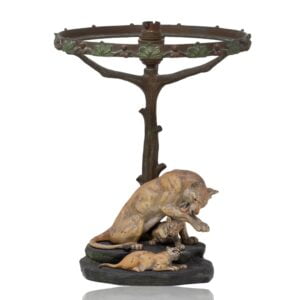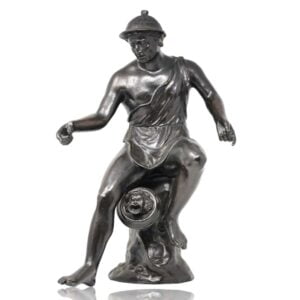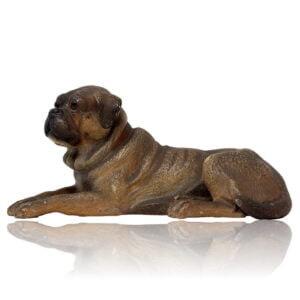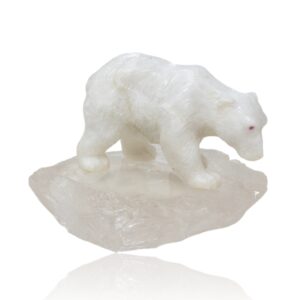Description
Art Deco Circa 1920
From our ceramic collection, we are delighted to offer this huge Amphora Art Deco Porcelain Group. The Amphora Porcelain Group of large size measuring 66.5cm High (26.18inches) is beautifully sculpted featuring two lionesses on the hunt attacking an elephant while the elephant tries to shake them off stood upon a rocky outcrop. The figure of lovely colour and detail stamped to the base multiple times with an embossed amphora logo within an oval cartouche, model number 8263 3, a second stamped logo with Amphora to the centre and made in Czechoslovakia and a third mark reading VI. The figure dating to the Art Deco period circa 1920.
Imperial Amphora in 1892 after 17 years as a leader in ceramics production, Alfred Stellmacher encouraged his son and sons-in-law to establish a porcelain manufacture business. Named after its owners Riessner, Stellmacher and Kessel (RSt&K), and employing son-in-law Paul Dachsel, the firm consistently marked pieces with the word Amphora, by the late 1890s it became known by that name alone.
The Amphora factory was located in Turn-Teplitz, Austria (now in the Czech Republic). Teplitz, once a spa town that attracted the likes of Goethe and Beethoven, had lost its luster over time because of the increasing intrusion of industrial activity. Turn, which had served Teplitz’s spa-goers with diversions including lush gardens and beautiful villas, was also affected by gradual industrialization. By the mid-19th century, the area formed a de facto ceramics production center that was also home to Kunstkeramik Paul Dachsel, Eduard Stellmacher, and Ernst Wahliss. Porcelain manufactories found the region advantageous because local riverbeds provided an abundant supply of kaolin (a soft white clay) an essential ingredient of porcelain.The rivers themselves were sources of energy, and the nearby railroads made it easier to quickly sell and export ceramics across Europe.
When originally incorporated, Amphora imitated the Orientalist and Neo-Baroque styles favored by Alfred Stellmacher. The combined talents of skilled designers like Eduard Stellmacher, Paul Dachsel, and a host of decorators from the Special Ceramics School of Teplitz allowed the Amphora manufacture to quickly develop a unique genre of Art Nouveau ceramics. What unified its output was an unparalleled concern for fine and high-quality design, as well as Alfred Stellmacher’s use of “ivory porcelain,” a matte yellowish material that was malleable, yet resistant to high temperatures. Amphora’s stylistic diversity, combined with its unwavering standard of quality, made it a world leader among industrial manufacturers of art pottery.
Porcelain is vitrified pottery (glass-like) with a white, fine-grained body that is usually translucent, which differs from earthenware as it is porous, opaque, and far coarser.
Art Deco is a style of visual arts, architecture and product design that first appeared in France just before World War I. It flourished in the United States and Europe during the 1920s to early 1930s. Through styling and design of the exterior and interior of anything from large structures to small objects, including how people look.
Measurements 66.5cm High x 40cm Wide x 28cm Deep (26.18 x 15.75 x 11.024 inches)
Condition Excellent, no damage and no restoration
With every purchase from Jacksons Antique, you will receive our latest product guide, full tracking information so you can monitor your shipment from start to finish and our personal no-hassle, money-back policy giving you that extra confidence when purchasing.






















